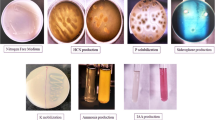Abstract
In the present study, attention has been paid to the development of economically feasible strategies for enhanced remediation of anthracene and its conversion into biofuels. The strategies developed (B1, B2, B3, and B4) include bagasse and lipid-producing strain Rhodotorula mucilagenosa IIPL32 synthesizing surface active metabolites. The results indicate the highest production of surface-active metabolites in strategies B2, B3, and B4 along with a maximum biodegradation rate. GC–MS analysis affirmed the conversion of anthracene into phthalic acid in all the strategies. Biofuel quality of the lipid produced by the strain showed higher cetane number and improved cold flow property indicating the efficiency of the developed strategies for the production of commercial grade biodiesel. Furthermore, the phytotoxicity study of the spent wash revealed that 50% and 75% diluted spent wash were non-toxic and can be employed for ferti-irrigation. Thus, the study signifies the development of an economically feasible process that can be commercially employed in biofuel industries.



Similar content being viewed by others
Data availability
All data generated or analyzed during this study are included in this published article.
References
Ambust S, Das AJ, Paul SK, Kumar R, Ghosh D (2022) Remediation and detoxification of oil contaminated marine intertidal sites through lipopeptide assisted washing strategy: an experimental and kinetic validation approach. Mar Pollut Bull 180:113817. https://doi.org/10.1016/j.marpolbul.2022.113817
Banks MK, Schultz KE (2005) Comparison of plants for germination toxicity tests in petroleum-contaminated soils. Water Air Soil Pollut 167(1):211–219. https://doi.org/10.1007/s11270-005-8553-4
Beal R, Betts WB (2000) Role of rhamnolipid biosurfactants in the uptake and mineralization of hexadecane in Pseudomonas aeruginosa. J Appl Microbiol 89:158–168. https://doi.org/10.1046/j.1365-2672.2000.01104.x
Cooper DG, Goldenberg BG (1987) Surface-active agents from two Bacillus species. Appl Environ Microbiol 53:224–229. https://doi.org/10.1128/aem.53.2.224-229.1987
Das AJ, Kumar R (2016) Bioremediation of petroleum contaminated soil to combat toxicity on Withaniasomnifera through seed priming with biosurfactant producing plant growth promoting rhizobacteria. J Environ Manag 174:79–86. https://doi.org/10.1016/j.jenvman.2016.01.031
Das AJ, Kumar R (2018) Bioslurry phase remediation of petroleum-contaminated soil using potato peels powder through biosurfactant producing Bacillus licheniformis J1. Int J Environ Sci Technol 15(3):525–532. https://doi.org/10.1007/s13762-017-1410-3
Das AJ, Ambust S, Singh T, Kumar R (2021) Biosurfactant assisted design treatments for remediation of petroleum contaminated soil and metabolomics based interactive study with Brassica nigra L. Environ Chall 4:100080. https://doi.org/10.1016/j.envc.2021.100080
Dasgupta D, Sharma T, Bhatt A, Bandhu S, Ghosh D (2017) Cultivation of oleaginous yeast Rhodotorula mucilaginosa IIPL32 in split column airlift reactor and its influence on fuel properties. Biocatal Agric Biotechnol 10:308–316. https://doi.org/10.1016/j.bcab.2017.04.002
Deeba F, Pruthi V, Negi YS (2018) Aromatic hydrocarbon biodegradation activates neutral lipid biosynthesis in oleaginous yeast. Bioresour Technol 255:273–280. https://doi.org/10.1016/j.biortech.2018.01.096
Hua F, Wang HQ (2014) Uptake and trans-membrane transport of petroleum hydrocarbons by microorganisms. Biotechnol Equip 28(2):165–175. https://doi.org/10.1080/13102818.2014.906136
Khot M, Ghosh D (2017) Lipids of Rhodotorula mucilaginosa IIPL32 with biodiesel potential: oil yield, fatty acid profile, fuel properties. J Basic Microbiol 57:345–352. https://doi.org/10.1002/jobm.201600618
Kumar R, Das AJ, Lal S (2015) Petroleum hydrocarbon stress management in soil using microorganisms and their products. In: Chandra M (ed) Environmental waste management, 1st edn. CRC Press, pp 539–564
Lamichhane S, Krishna KB, Sarukkalige R (2017) Surfactant-enhanced remediation of polycyclic aromatic hydrocarbons: a review. J Environ Manag 199:46–61. https://doi.org/10.1016/j.jenvman.2017.05.037
Sharma T, Sailwal M, Dasgupta D, Hazra S, Bhaskar T, Ghosh D (2021) Effect of lignocellulosic biomass inhibitors on oleaginous yeast cultivation in multistage fermentation system. Bioresour Technol Reports 15:100791–100796. https://doi.org/10.1016/j.biteb.2021.100791
Talebi AF, Tabatabaei M, Chisti Y (2014) Biodiesel analyzer: a user-friendly software for predicting the properties of prospective biodiesel. Biofuel Res J 1(2):55–57. https://doi.org/10.18331/BRJ2015.1.2.4
Tiquia SM, Tam NFY, Hodgkiss IJ (1996) Effects of composting on phytotoxicity of spent pig manure sawdust litter. Environ Pollut 93:249–256. https://doi.org/10.1016/S0269-7491(96)00052-8
Todaka M, Horinouchi T, Yata K, Kowhakul W, Masamoto H, Shigematsu M (2014) Reduction of the cloud point of biodiesel by combination of various factors. Int J Chem Eng Appl 5(6):479–482. https://doi.org/10.7763/IJCEA.2014.V5.432
Van den Berg B (2010) Going forward laterally: transmembrane passage of hydrophobic molecules through protein channel walls. Chem Bio Chem 11:1339–1343. https://doi.org/10.1038/nature07678
Ye JS, Yin H, QiangJ PH, Qin HM, Zhang N, He BY (2011) Biodegradation of anthracene by Aspergillus fumigatus. J Hazard Mater 185(1):174–181. https://doi.org/10.1016/j.jhazmat.2010.09.015
Acknowledgements
The authors thankfully acknowledge Director CSIR-Indian Institute of Petroleum, for his constant encouragement and support. Ayan Banerjee is thankful to UGC for SRF fellowship.
Funding
CSIR AN&B FBR grants MLP-1167 and MLP-1168 to Debashish Ghosh and UGC NET SRF (File No. 3812/(NET-DEC2018)) grant to Ayan Banerjee.
Author information
Authors and Affiliations
Contributions
All authors contributed to the study’s conception and design. Material preparation, data collection, and analysis were performed by Amar Jyoti Das and Ayan Banerjee. Data analysis and validation were further performed by Ananya Tyagi and Arijit Jana. The first draft of the manuscript was written by Amar Jyoti Das and Ayan Banerjee. Writing — review and editing, supervision, and project administration were monitored by Dr. Thallada Bhaskar and Dr. Debashish Ghosh. All authors commented on previous versions of the manuscript. All authors read and approved the final manuscript.
Corresponding author
Ethics declarations
Ethics approval and consent to participate
Not applicable.
Consent for publication
Not applicable.
Competing interests
The authors declare no competing interests.
Additional information
Responsible Editor: Ta Yeong Wu
Publisher's Note
Springer Nature remains neutral with regard to jurisdictional claims in published maps and institutional affiliations.
Rights and permissions
Springer Nature or its licensor (e.g. a society or other partner) holds exclusive rights to this article under a publishing agreement with the author(s) or other rightsholder(s); author self-archiving of the accepted manuscript version of this article is solely governed by the terms of such publishing agreement and applicable law.
About this article
Cite this article
Das, A.J., Banerjee, A., Tyagi, A. et al. Enhanced remediation of polyaromatic hydrocarbon using agro-industrial waste for biofuel production and environmental pollution mitigation. Environ Sci Pollut Res (2023). https://doi.org/10.1007/s11356-023-29627-x
Received:
Accepted:
Published:
DOI: https://doi.org/10.1007/s11356-023-29627-x




